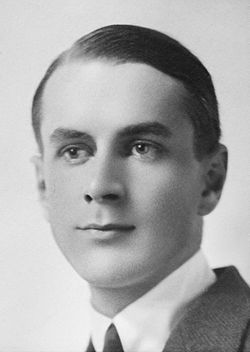Nils von Dardel
| Nils Dardel | |
|---|---|

Nils Dardel in Tokyo 1917
|
|
| Born |
25 October 1888 Bettna, Södermanland |
| Died | 25 May 1943 New York City |
| Nationality | Swedish |
| Alma mater | Royal Swedish Academy of Arts |
| Notable work | Den döende dandyn |
| Style | Post-Impressionism |
| Spouse(s) | Thora Dardel |
Nils Dardel (full name Nils Elias Kristofer von Dardel, sometimes known as Nils de Dardel) was a 20th-century Swedish Post-Impressionist painter, grandson to famous Swedish painter Fritz von Dardel.
Dardel was born in Bettna, Södermanland, Sweden in 1888. He studied at the Royal Swedish Academy of Arts in Stockholm between 1908–1910. Some of his most famous paintings are Den döende dandyn, Crime Passionnel, Svarta Diana and John blund.
Nils Dardel was born into the Swedish noble family von Dardel, son of the landowner Fritz August von Dardel and Sofia Matilda Norlin. His grandfather was the Swedish painter Fritz von Dardel, adjutant to the later king Charles XV of Sweden and member of the Royal Swedish Academy of Arts in Stockholm, where Nils later studied between 1908–1920, and of which he eventually became a member in 1934.
In 1919 he proposed to Nita Wallenberg, but her father, a Swedish diplomat, disapproved of Dardel and the marriage was not to be. This was linked closely to the creation of his work Exekution (Execution), which is said to be symbolic of the rejection.
Nils Dardel married the author Thora Dardel (1899–1995 – née Klinckowström), which lasted between 1921–1934. Together they had a daughter Ingrid von Dardel (1922–1962) who like her father became an artist. Both her sons Henry Unger (born 1945 – father Gustav Unger) and Nils Ekwall (born 1954 – father Lage Ekwall) in turn were also active Swedish artists.
After the marriage to Thora, sometime in the 1930s Nils meets Edita Morris (1902–1988, née Toll), a Swedish writer with whom he shares his remaining life.
After studying in Sweden he did as many of his contemporaries and traveled to Paris around 1910 (such as Leander Engström, Isaac Grünewald, Einar Jolin, and Sigrid Hjerten who all became students of Henri Matisse). Dardel primarily took inspiration from the Fauvists with their pure palette, the Post-Impressionists, as well as Japanese woodcuts. Dardel also made a brief foray into Cubism, and painted a few cityscapes in the style.
...
Wikipedia
